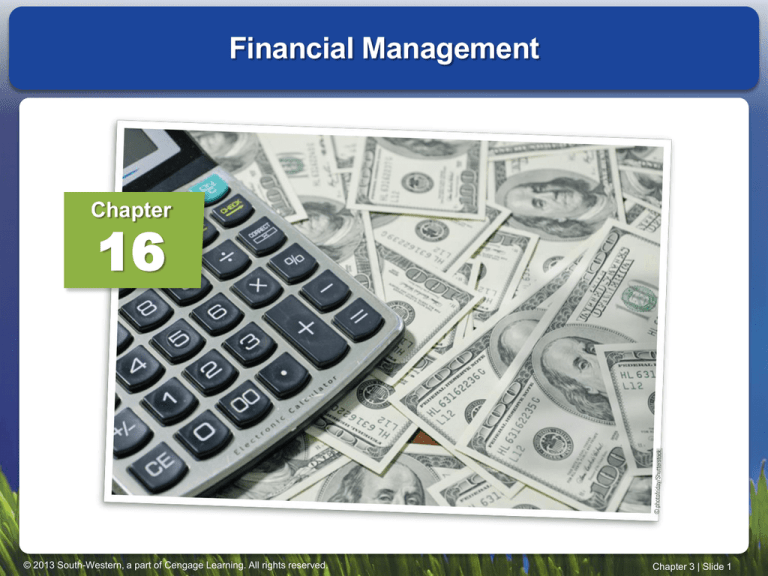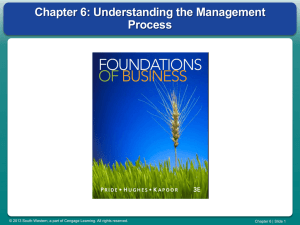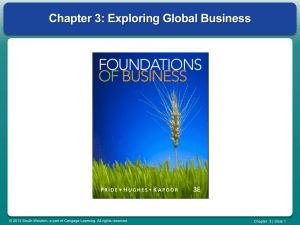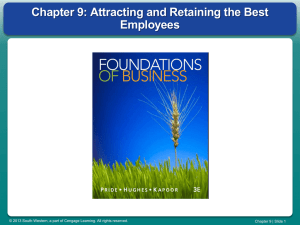
Financial Management
Chapter
16
© 2013 South-Western, a part of Cengage Learning. All rights reserved.
Chapter 3 | Slide 1
What Is Financial Management?
All the activities concerned with obtaining
money and using it effectively
The need for financing
• When expenses are high or sales are low
• When there are opportunities to expand
© 2013 South-Western, a part of Cengage Learning. All rights reserved.
Chapter 3 | Slide 2
Types of Financing
Short-term financing
• Money that will be used for one year or less
Long-term financing
• Money that will be used for longer than one year
• Often involves large amounts of money
© 2013 South-Western, a part of Cengage Learning. All rights reserved.
Chapter 3 | Slide 3
Comparison of
Short- and Long-Term Financing
© 2013 South-Western, a part of Cengage Learning. All rights reserved.
Chapter 3 | Slide 4
Cash Flow for a Manufacturing Business
© 2013 South-Western, a part of Cengage Learning. All rights reserved.
Chapter 3 | Slide 5
The Cash Flow Cycle
Customers
Sales
Accounts
Receivable
Inventory
Cash
© 2013 South-Western, a part of Cengage Learning. All rights reserved.
Chapter 3 | Slide 6
Financial Management During the
Economic Crisis
Proper financial management at all times
must ensure that:
• Financing priorities are established in line with
•
•
•
•
•
•
organizational goals
Spending is planned and controlled
Sufficient financing is available when it is needed
Credit customers pay their bills on time and past-due or
delinquent accounts are reduced
Bills are paid promptly to protect the firm’s credit rating
and ability to borrow money
Funds are always available to pay taxes on time
Excess cash is invested in CDs, government securities,
or conservative marketable securities
© 2013 South-Western, a part of Cengage Learning. All rights reserved.
Chapter 3 | Slide 7
Planning—the Basis of Sound
Financial Management
Financial plan
• A plan for obtaining and using the money needed to
implement an organization’s goals
Developing the financial plan
• Establish organizational goals
• Determine how much money is needed to
accomplish each goal
• Identify sources of funds and which to use
© 2013 South-Western, a part of Cengage Learning. All rights reserved.
Chapter 3 | Slide 8
The Three Steps of Financial Planning
© 2013 South-Western, a part of Cengage Learning. All rights reserved.
Chapter 3 | Slide 9
Developing the Financial Plan
Identifying sources of funds
• Sales
– Provide the greatest part of the firm’s financing
• Equity capital
– Money received from the owners or from the sale of shares
of ownership in the business
• Debt capital
–
Borrowed money obtained through loans
• Sale of assets
– If absolutely necessary or when no longer needed
Monitoring and evaluating financial performance
• Prevents minor problems from becoming major ones
© 2013 South-Western, a part of Cengage Learning. All rights reserved.
Chapter 3 | Slide 10
Cash Budget for Stars and
Stripes Clothing
© 2013 South-Western, a part of Cengage Learning. All rights reserved.
Chapter 3 | Slide 11
Sources of Unsecured
Short-Term Financing
What is Unsecured financing?
• Financing not backed by collateral
What kinds of unsecured financing are there?
(4)
1. Trade credit
–
Financing extended by a seller who does not require
immediate payment after the delivery of the merchandise
2. Promissory notes
–
–
–
–
A written pledge by a borrower to pay a certain sum of
money to a creditor at a specified future date
Unlike trade credit, promissory notes usually include
interest
Legally binding
Negotiable instruments
© 2013 South-Western, a part of Cengage Learning. All rights reserved.
Chapter 3 | Slide 12
Sources of Unsecured
Short-Term Financing (cont.)
3.
Unsecured bank loans
• Interest rates vary with each borrower’s credit rating
• Prime interest rate
–
The lowest rate charged by a bank for a short-term loan
• Offered through promissory notes, a line of credit,
or revolving credit agreement
4.
Commercial paper
• Short-term promissory note issued by a
large corporation
• Interest rates are usually below that charged by
banks for short-term loans
© 2013 South-Western, a part of Cengage Learning. All rights reserved.
Chapter 3 | Slide 13
Sources of Secured Short-Term Financing
What is Secured financing?
• Loans secured by inventory
– Inventory is pledged as collateral
– Control of the inventory passes to the lender
until the loan is repaid
– If the lender requires storage of inventory used
as collateral in a public warehouse, the borrower
pays storage fees
• Loans secured by receivables
– Amounts owed to a firm by its customers are pledged
as collateral
– Quality of receivables is considered
© 2013 South-Western, a part of Cengage Learning. All rights reserved.
Chapter 3 | Slide 14
Sources of Equity Financing
For sole proprietorships or partnerships
• Owner or owners invest money in the business
• Venture capital
For corporations
• Sale of stock
• Retained earnings-Use of profits not distributed to
stockholders
• Venture capital-will invest in firms that have the
potential of becoming extremely profitable. In return,
they usually require a percent ownership of the
business.
© 2013 South-Western, a part of Cengage Learning. All rights reserved.
Chapter 3 | Slide 15
Sources of Equity Financing (cont.)
Selling stock
• Initial public offering
– When a corporation sells common stock to the
general public for the first time
–
Why does a company “go public”?
–
What is involved in an IPO?
• Advantages of selling stock
– Firm does not have to repay money received
from sale of stock
– Firm does not have to pay dividends to stockholders
unless they decide to.
© 2013 South-Western, a part of Cengage Learning. All rights reserved.
Chapter 3 | Slide 16
Sources of Equity Financing (cont.)
Selling stock (cont.)
• Common stock
– Stock whose owners may vote on corporate matters
but whose claims on profits and assets are
subordinate to the claims of others
• Preferred stock
– Stock whose owners usually do not have voting rights,
but whose claims on dividends and assets are paid
before those of common-stock owners
© 2013 South-Western, a part of Cengage Learning. All rights reserved.
Chapter 3 | Slide 17
Using the Internet
The New York Stock Exchange and the NASDAQ
are the two most cited equity markets. Each
provides financial information about the companies
it lists and news that might influence their stock
values.
http://www.nyse.com
http://www.nasdaq.com
© 2013 South-Western, a part of Cengage Learning. All rights reserved.
Chapter 3 | Slide 18
Sources of Long-Term Debt Financing
Financial leverage
• The use of borrowed funds to increase the
return on owners’ equity
• As long as the firm’s earnings are larger than the
interest charged for the borrowed money, it is ok
to borrow.
© 2013 South-Western, a part of Cengage Learning. All rights reserved.
Chapter 3 | Slide 19
Sources of Long-Term Debt Financing (cont.)
Long-term loans
• Term-loan agreement
–
For loans longer than one year.
– A promissory note requires a borrower to repay a loan in monthly,
quarterly, semiannual, or annual installments.
– Interest rate and repayment terms are based on the reasons for
borrowing, the firm’s credit rating, and the value of collateral.
• The basics of getting a loan
–
–
–
–
–
Know potential lenders.
Maintain a good credit rating.
Fill out an application, submit a business plan
and financial statements, and compile references.
Meet with loan officer.
If denied, determine why.
© 2013 South-Western, a part of Cengage Learning. All rights reserved.
Chapter 3 | Slide 20
Chapter Quiz
1. Retained earnings, as a form of equity
financing, are
A.
B.
C.
D.
E.
gross earnings.
profits before taxes.
profits after taxes.
undistributed profits.
total owners’ equity.
© 2013 South-Western, a part of Cengage Learning. All rights reserved.
Chapter 3 | Slide 21
Chapter Quiz
2. True or False. The primary sources of funds
available to a business include all of the
following:
2.
3.
4.
5.
debt capital.
equity capital.
sales revenue.
sale of assets.
© 2013 South-Western, a part of Cengage Learning. All rights reserved.
Chapter 3 | Slide 22





